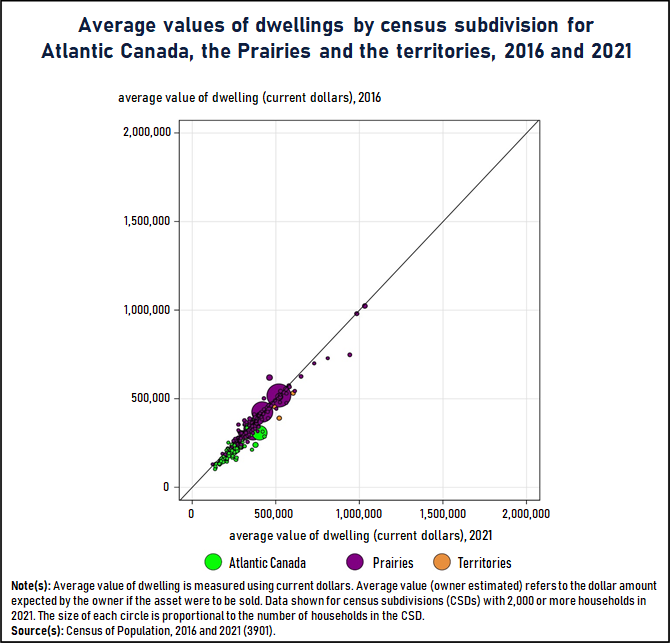Infographic 4
Change in owner's expected value of their dwelling in census subdivisions in the Prairies, the territories and Atlantic Canada

Infographic description
The title of the infographic is "Change in owner's expected value of their dwelling in census subdivisions in the Prairies, the territories and Atlantic Canada"
This is a bubble chart showing a comparison of the average values of dwellings in current dollars from 2016 to 2021 for census subdivisions in Atlantic Canada, the Prairies and the territories with 2,000 or more households in 2021. Atlantic Canada is composed of Newfoundland and Labrador, Prince Edward Island, Nova Scotia, and New Brunswick. The Prairies are composed of Manitoba, Saskatchewan and Alberta. The territories are composed of Yukon, the Northwest Territories and Nunavut.
The horizontal axis shows the average value of dwelling (current dollars) in 2021, from $0 to $2,000,000 in intervals of $500,000.
The vertical axis shows the average value of dwelling (current dollars) in 2016, from $0 to $2,000,000 in intervals of $500,000.
The chart includes a diagonal 45-degree line that shows where the average value of dwelling in 2016 equals the average value of dwelling in 2021.
Each census subdivision is shown as a circle, the size of which represents the number of households in the census subdivision.
The circles are colour-coded to each provincial grouping; circles are coloured green for census subdivisions in Atlantic Canada, purple for census subdivisions in the Prairies and orange for census subdivisions in the territories.
Most census subdivisions show little to no growth in the average value of dwelling from 2016 to 2021, and some census subdivisions have shown a decline in the average value. The census subdivisions from all provincial groupings tend to be clustered together, close to the 45-degree line.
In Atlantic Canada, 80% of census subdivisions had an average value of dwelling between $170,000 and $350,000 in 2021. The lowest average value of dwelling in Atlantic Canada was approximately $135,000 in 2021, and the highest average value of dwelling was approximately $430,000. In 80% of census subdivisions, the average value of dwelling grew between 0% and 40% from 2016 to 2021. Of census subdivisions, 10% saw a decline in the average value of dwelling from 2016 to 2021. The smallest increase in the average value of dwelling was 0.1%, and the largest increase was 68.5%. The smallest decrease in the average value of dwelling was 0.6%, and the largest decrease was 14.3%.
In the Prairies, 80% of census subdivisions had an average value of dwelling between $260,000 and $530,000 in 2021. The lowest average value of dwelling in the Prairies was approximately $120,000 in 2021, and the highest average value of dwelling was approximately $1,000,000. One-third of census subdivisions in the Prairies experienced a decrease in the average value of dwelling from 2016 to 2021, ranging from a 0.2% decrease to a 25.3% decrease. The remaining two-thirds of census subdivisions experienced an increase in the average value of dwelling ranging from a 0.1% increase to a 29.1% increase.
In the territories, only three census subdivisions had 2,000 or more households and were included in the chart: Whitehorse, Yellowknife and Iqaluit. In Whitehorse, the average value of dwelling was approximately $520,000 in 2021, an increase of 33.4% from 2016. In Yellowknife, the average value of dwelling was approximately $490,000 in 2021, an increase of 8.9% from 2016. In Iqaluit, the average value of dwelling was approximately $600,000, an increase of 13.5% from 2016.
Note(s): Average value of dwelling is measured using current dollars. Average value (owner estimated) refers to the dollar amount expected by the owner if the asset were to be sold. Data shown for census subdivisions (CSDs) with 2,000 or more households in 2021. The size of each circle is proportional to the number of households in the CSD.
Source(s): Census of Population, 2016 and 2021 (3901).
- Date modified: